Wenn Sie ein Experte für die Erstellung von Block- und Kursivbuchstaben werden, Möglicherweise finden Sie ein neues Problem, bei dem es sich um kleine Stickereien handelt.
Sie müssen sich jedoch keine Sorgen machen, da wir hier sind, um kleine gestickte Buchstaben zu erstellen und qualitativ hochwertige Ergebnisse zu erzielen.
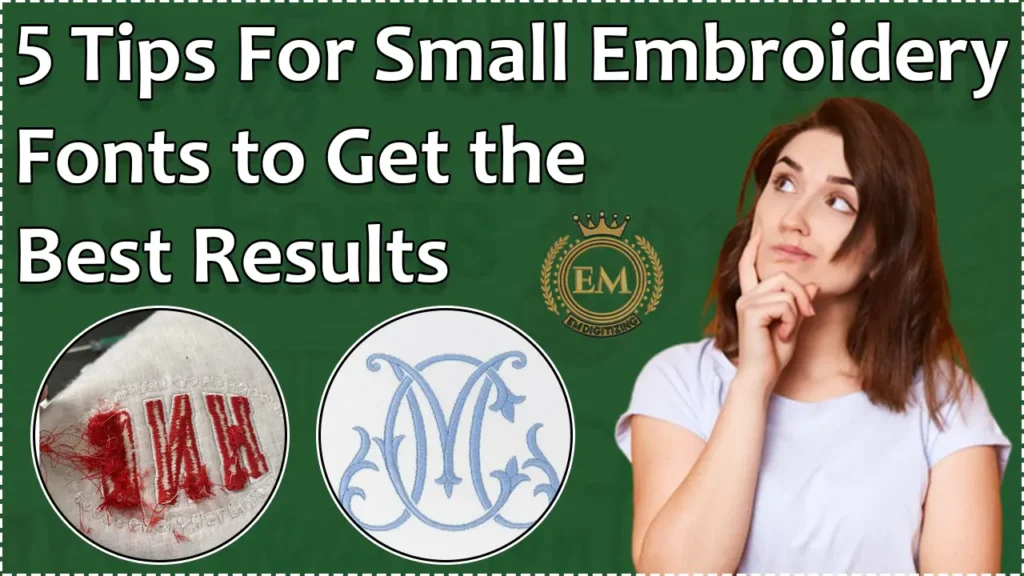
5 Tipps für kleine Stickschriften, um die besten Ergebnisse zu erzielen
Was sind kleine Stickereien?
Klein Stickbriefe sind genau wie der Name: kleine Schriftarten. Es gibt viele winzige Schriftarten für die Maschinenstickerei. Sie können sie auf unterschiedliche Weise für Logos oder Patches verwenden.
Wenn Sie sie verwenden, müssen Sie die Verwendung von Material verwenden, Schriftgröße, und Anzahl der Briefe im Design. Jedoch, Kleine gestickte Buchstaben sind schwer zu bedienen, da Sie Genauigkeit und Präzision in der Stickerei benötigen, um klare Ergebnisse zu erzielen.
Einige Kunden wollen die gleichen kleinen Schriftarten auf ihren T-Shirts, die sie auf gedruckten Artikeln sehen. Aber als Sticker, Sie müssen sie darüber leiten, welche Größe und Schriftarten am besten funktionieren.
Was sind die Probleme, mit denen Sie mit kleinen Stickereien konfrontiert sind?
Wenn Sie Buchstaben auf ein Hemd sticken, das sich in kleiner Größe befindet, können Sie diesen Problemen konfrontiert:
Vogelverschachtelung
Dieses Problem tritt auf, wenn es in einem kleinen Bereich viele Stiche gibt. Diese führen dazu, dass die Nadel im Faden stecken oder gefangen ist.
Wenn Sie weitere Gründe kennenlernen möchten, die Vogelverschachteln verursachen, lesen Sie unseren Blog von Klicken Sie hier.
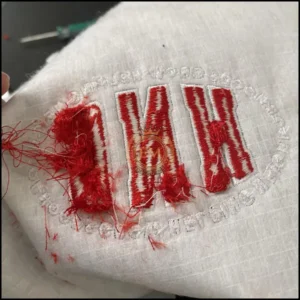
Risiko von Löchern:
Sie können Löcher im Stoff erstellen, wenn Ihre Stickerei so viele kleine Stiche in einem kreisförmigen Design hat. Dies ist nicht akzeptabel, wenn Sie kleine Stickbuchstaben auf Polo -Shirts sticken.
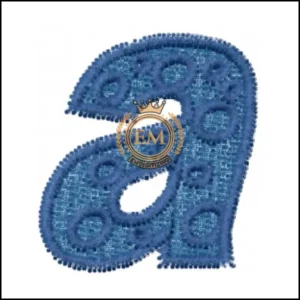
Schwer zu lesen:
Wenn Sie viele kleine Stiche in einem kleinen Bereich haben, Es erschwert den Text zu lesen. Dies geschieht insbesondere bei der Verwendung von Baumwollstoff oder eine andere Art von Stoff Das kann schrumpfen, weil es das Problem verschlimmert.
Aber mit den richtigen Werkzeugen und Techniken, Sie können die besten Ergebnisse erhalten, wenn Sie klein verwenden Stickschriften.
5 Tipps für die Verwendung kleiner Stickereien:
Einige von Ihnen denken vielleicht, dass wir immer wieder über schlechte Nachrichten sprechen.?
Jetzt, Es ist Zeit für gute Nachrichten!
Wenn Sie eine qualitativ hochwertige Stitch-Schriftzufer-Schriftart wünschen, müssen Sie intelligente Auswahlmöglichkeiten über Ihren Stabilisator treffen, Stoff, Schriftstil, und Schriftgröße.
Sprechen wir über einige Faktoren, die Ihr endgültiges Design beeinflussen können.
1. Stofftypen für kleine Stickbuchstaben:
Strickstoff ist dicker und atmungsaktiv, was es für Sporthemden nützlich ist. Sie können es auch Honeycomb -Gewebe nennen, da es manchmal schwierig sein kann, darüber zu sticken und die Stiche in den Stoff versinken.
Rutschige Stoffe wie Seide können auch schwer zu sticken kleine Buchstaben, weil sie nicht genug Stabilität haben und die Form der Buchstaben verändern können. Wir empfehlen Ihnen auch, dass Sie es vermeiden, einen stationären Stoff wie ein Netz zu verwenden.
Profi-Tipp: Wenn der Stoff stabil ist, können Sie leicht darauf sticken. Sie können gewebter Stoff verwenden, da er eine hohe Stabilität hat und sich hervorragend für winzige Schriftarten eignet.
Schauen Sie sich unserem Blog an, wenn Sie das erkunden möchten Bester Stoff für Stickereien.
2. Stilüberlegungen für Briefe:
Bei Betrachtung der Buchstaben für Stickerei digitalisieren Es gibt eine Daumenregel: Wenn das Detail weniger ist, ist das Ergebnis besser. Sie müssen dies besonders berücksichtigen, wenn Sie klein machen Stickmotive.
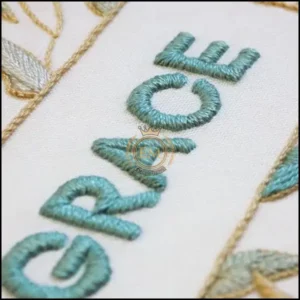
Wir wissen, dass das Sticken mutiger oder Wirbelstatten angenehm ist, aber wenn Sie kleine Buchstaben sticken, empfehlen wir Ihnen, sich mit grundlegender Schrift zu befassen, da dies Ihnen genauere Ergebnisse liefert.
Darüber hinaus, Bei der Auswahl kleiner Stickereien empfehlen wir, Blockbuchstaben zu verwenden und nicht kursiv, da sie lesbarer sind.
Die kleinste Textgröße beträgt normalerweise etwa 3 mm bis 4 mm, und Sie müssen bedenken, dass die Größe, wenn die Größe so klein ist, schwer zu lesen ist.
3. Verwenden Sie die richtige Art von Stabilisator und Unterlagen:
Wenn Sie mit kleinen Stickereien arbeiten, müssen Sie Ihren Stoff unterlegen.
Let’;s zuerst darüber sprechen, was ist Unterlage in der Maschinenstickerei.
Brunnen, Es ist wie eine Grundlage für Ihr Stickmuster. Sie können es auf unterschiedliche Weise anwenden, da es die gleichen Funktionen bietet: Es hält das Design an Ort und Stelle und verhindert Verzerrungen.
Es gibt ein paar Dinge, an die Sie sich erinnern müssen, wenn Sie den Stoff unterlegen, Besonders für winzige Schriftarten.
- Für winzige Schriftarten, es wird empfohlen zu Unterlagen anwenden in der Mitte, weil es das Design unterstützt, um auf den Stoff zu kleben.
- Versuchen Sie zu vermeiden, den Edge -Lauf auf kleinen Schriftarten zu verwenden, da es nicht genügend Stabilität bietet.
- Sie können auch verwenden Knockdown -Stiche Weil sie auch eine Art Unterlage sind. Es scheint wie ein Tatami -Stich zu.
Wenn Sie ein Unterlagen verwenden, müssen Sie die weniger Stichdichte beibehalten. Glauben Sie uns, "weniger ist mehr". Es ist ratsam, die Dichte als Fehler beizubehalten, damit Sie High-End-Ergebnisse erzielen können.
Aber wenn wir über Stabilisatoren sprechen, folgen Sie dieser Regel: Mehr Stabilisator bedeutet besser Stickerei. Wir empfehlen, dass Sie mindestens zwei Stabilisatorschichten anwenden.
Um mehr über die zu lesen Stabilisator in Stickerei Schauen Sie sich unseren Blog an.
4. Kleine Stickernadel- und Fadenempfehlungen:
Sie sollten eine kleine Nadelgröße verwenden, wenn Sie winzige Schriftarten sticken. Denn wenn eine kleine Nadel durch den Stoff geht, hinterlässt sie kleine Löcher. Die Auswahl der Nadeln hängt auch von der Art des verwendeten Stoffes ab.
Wenn Sie mit Strickstoff arbeiten, sollten Sie eine Kugelscheibe -Nadel auswählen. Andererseits, Bei der Verwendung gewebter Stoff sollten Sie mit einer scharfen spitzen Nadel gehen.
Die grosse von Stickgarn beeinflusst auch die Qualität. So, Für kleine Stickereien, Wir schlagen vor, mit einem 60-Gewicht-Thread zu gehen. Probieren Sie es jedoch in einem Ersatzstoff aus, um zu sehen, wie es aussieht, bevor Sie den tatsächlichen Stoff sticken.
Lassen Sie uns dies mit einem Beispiel verstehen, in dem wir vergleichen 40 und 60-Gewichts-Faden zum Sticken mit 75/11 und 65/9 Größe Nadeln.
Standard Block-Schriftart ist auf dem Baumwollgewebe mit 40-Gewicht-Faden und Tränenstabilisator bestickt.
Und, Schauen Sie sich nun dieses Bild an, in dem die gleichen Stickereien mit 60-Gewicht-Stoff auf demselben Material bestickt sind.
Jetzt, Sie können einen klaren Unterschied in sehen Wie das Gewicht des Fadens und Nadelgröße beeinflusst die Qualität.
Erinnern: Slow down the machine’;S -Geschwindigkeit, weil das Faden ziehen und das Nähen gleicherlanger wird.
5. Stichlänge und Dichte kleiner Stickereien:
Als an Experten -Digitalisierer, Wir empfehlen, das Design winziger Schriftarten nicht zu ändern und sie zu verwenden, da es sich in digitalisiertem Design befindet. Wenn die Dichte unter 0,25 mm ist, bedeckt sie den gesamten Stoff und macht schließlich ein Loch.
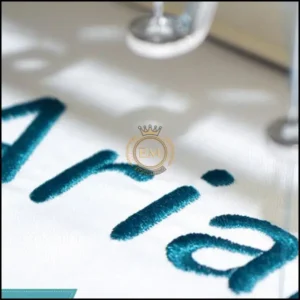
Sie können die Pull -Kompensation auch erhöhen, wenn Sie möchten. Sie müssen jedoch darauf achten, nicht zu stark zu erhöhen, weil das Design unlesbar ist. Ebenfalls, Sie sollten die Stichlänge auf mindestens 1 mm einstellen oder die Standardstichlänge so lassen, wie sie ist.
Zum Beispiel, Wenn Sie Löcher in einem Eröffnungsbuchstaben wie „E“ verhindern möchten, stellen Sie die Stichlänge auf 1 mm ein.
Endeffekt:
Übung und Geduld sind der Schlüssel, um das beste Ergebnis bei der Verwendung kleiner Stickereien zu erzielen. Aber Sie müssen sich an einige wichtige Punkte erinnern. Zuerst, slow down the embroidery machine’;s Geschwindigkeit, die Verzerrungen verhindert.
Zweite, Wählen Sie den richtigen Stoff und Stabilisator, der für kleine Buchstaben hervorragend funktioniert. zuletzt, Verwenden Sie eine kleine Nadel- und 60-Gewichts-Faden, damit Sie genauere Ergebnisse erzielen können.
Wenn Sie mit kleinen Schriftarten immer noch Probleme haben, sind wir hier, um Sie zu führen.
Sie können uns auch einstellen kleine Buchstaben digitalisieren In Stickerei mit High-End-Ergebnissen. Wir konvertieren Ihre Designs in eine Stickdatei, die ohne Fehler mit Ihrer Maschine kompatibel ist.
Wir bieten unseren Erstkunden a an 50% Rabatt auf alle unsere Dienstleistungen, plus ein kostenloses Angebot, das in weniger als einem Monat erstellt wird 5 Protokoll.
Sie können uns kontaktieren und Fragen zu diesem Artikel stellen, and don’;Vergessen Sie nicht, es mit Leuten zu teilen, von denen Sie glauben, dass es nützlich sein könnte.
Viel Glück für Sie!
Vielen Dank fürs Lesen!
Häufig gestellte Fragen:
Die beste Schriftart für kleine Buchstaben in Stickerei ist Futura -Kondensat, die hauptsächlich in Monogrammen oder Logos verwendet wird. Es hat ein modernes und sauberes Aussehen, das für viele Arten von Designs hervorragend funktioniert.
- Comic ohne reguläre
- Arial schwarz
- Baskerville regulär
- Caslon 3 Regulär
- Alternative gotische reguläre
- Gotham regulär
Polyneon 60 ist am besten für kleine Schriftarten in Stickereien, um feine Details zu haben. Ebenfalls, Stellen Sie sicher 65/9 Größennadeln und erhöhen die Stichdichte.
Die empfohlene Größe der Stickerei ist 2 Zoll. Aber für geschlossene Buchstaben wie B, d, und p Die Schriftgröße muss mindestens sein 0.2 Zoll, um ein lesbares Finish zu verleihen.
Der Roboto -Schriftstil eignet sich am besten für kleine Schriftarten, da sie auf kleinste Größe lesbar sind und nicht einmal ihre Eleganz verlieren.
